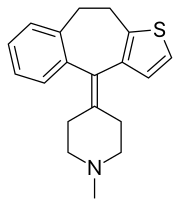Pizotifen
Pizotifen (INN) or pizotyline (USAN), trade name Sandomigran, is a benzocycloheptene-based drug used as a medicine, primarily as a preventive to reduce the frequency of recurrent migraine headaches.[1]
 | |
| Clinical data | |
|---|---|
| Trade names | Sandomigran |
| AHFS/Drugs.com | International Drug Names |
| Pregnancy category |
|
| Routes of administration | Oral |
| ATC code | |
| Legal status | |
| Legal status | |
| Pharmacokinetic data | |
| Bioavailability | 78% |
| Protein binding | 91% |
| Metabolism | Glucuronidation (main route). N-glucuronide accounts for >50% of plasma and 60–70% of urinary excreted drug |
| Elimination half-life | 23 hours |
| Excretion | 18% feces, 55% urine (both as metabolites) |
| Identifiers | |
IUPAC name
| |
| CAS Number | |
| PubChem CID | |
| IUPHAR/BPS | |
| ChemSpider | |
| UNII | |
| KEGG | |
| ChEMBL | |
| CompTox Dashboard (EPA) | |
| ECHA InfoCard | 100.036.014 |
| Chemical and physical data | |
| Formula | C19H21NS |
| Molar mass | 295.443 g/mol g·mol−1 |
| 3D model (JSmol) | |
SMILES
| |
InChI
| |
| | |
Uses
The main medical use for pizotifen is for the prevention of migraine and cluster headache. Pizotifen is one of a range of medications used for this purpose, other options include propranolol, topiramate, valproic acid, cyproheptadine and amitriptyline. While pizotifen is reasonably effective,[2] its use is limited by side effects, principally drowsiness and weight gain, and it is usually not the first choice medicine for preventing migraines, instead being used as an alternative when other drugs have failed to be effective.[3] It is not effective in relieving migraine attacks once in progress. Pizotifen has also been reported as highly effective in a severe case of erythromelalgia, a rare neurovascular disease that is sometimes refractory to the other drugs named above.[4]
Other applications for which pizotifen may be used include as an antidepressant, or for the treatment of anxiety or social phobia.[5][6] Animal studies also suggest that pizotyline could be used in the treatment of serotonin syndrome or MDMA overdose[7] in a similar manner to the closely related antihistamine/antiserotonin medication cyproheptadine.
Adverse effects
Side effects include sedation, dry mouth, drowsiness, increased appetite and weight gain.[8] Occasionally it may cause nausea, headaches, or dizziness. In rare cases, anxiety, aggression and depression may also occur.
Contraindications
Caution is required in patients having closed angle glaucoma and in patients with a predisposition to urinary retention as the medication exhibits a relatively small anticholinergic effect. Dose adjustment is required in people who have chronic kidney disease. Liver injury has also been reported. Pizotifen treatment should be discontinued if there is any clinical evidence of liver dysfunction during treatment. Caution is advised in patients having a history of epilepsy. Withdrawal symptoms like depression, tremor, nausea, anxiety, malaise, dizziness, sleep disorder and weight decrease have been reported following abrupt cessation of pizotifen.[9] Pizotifen is contraindicated in patients who suffer from hypersensitivity to any of its components, also Pizotifen is contraindicated in gastric outlet obstruction, pregnancy, angle-closure glaucoma and difficulty urinating.[10]
Pharmacology
Pizotifen is a serotonin antagonist acting mainly at the 5-HT2A and 5HT2C receptors. It also has some activity as an antihistamine as well as some anticholinergic activity.[11]
See also
- Benzocycloheptene
- Cyproheptadine
- Ketotifen
References
- Stark RJ, Valenti L, Miller GC. Management of migraine in Australian general practice. Medical Journal of Australia. 2007 Aug 6;187(3):142-6.
- Barnes N, Millman G. Do pizotifen or propranolol reduce the frequency of migraine headache? Archives of Disease in Childhood. 2004 Jul;89(7):684-5.
- Pierangeli G, Cevoli S, Sancisi E, Grimaldi D, Zanigni S, Montagna P, Cortelli P. Which therapy for which patient? Neurological Sciences. 2006 May;27 Suppl 2:S153-8.
- Cohen JS. Erythromelalgia: new theories and new therapies. J Am Acad Dermatol. 2000 Nov;43(5 Pt 1):841-7
- Standal JE. Pizotifen as an antidepressant. Acta Psychiatrica Scandinavica. 1977 Oct;56(4):276-9.
- Banki CM. Clinical observations with pizotifene (Sandomigran) in the treatment of nonmigrainous depressed women. Archiv für Psychiatrie und Nervenkrankheiten. 1978 Mar 7;225(1):67-72.
- Young R, Khorana N, Bondareva T, Glennon RA. Pizotyline effectively attenuates the stimulus effects of N-methyl-3,4-methylenedioxyamphetamine (MDMA). Pharmacology Biochemistry and Behavior. 2005 Oct;82(2):404-10.
- Crowder D, Maclay WP. Pizotifen once daily in the prophylaxis of migraine: results of a multi-centre general practice study. Current Medical Research and Opinion. 1984;9(4):280-5.
- "Emedicine".
- "Likarstwo.ru".
- Dixon AK, Hill RC, Roemer D, Scholtysik G. Pharmacological properties of 4-(1-methyl-4-piperidylidine)-9,10-dihydro-4H-benzo-[4,5]cyclohepta[1,2]-thiophene hydrogen maleate (pizotifen). Arzneimittelforschung. 1977;27(10):1968-79.